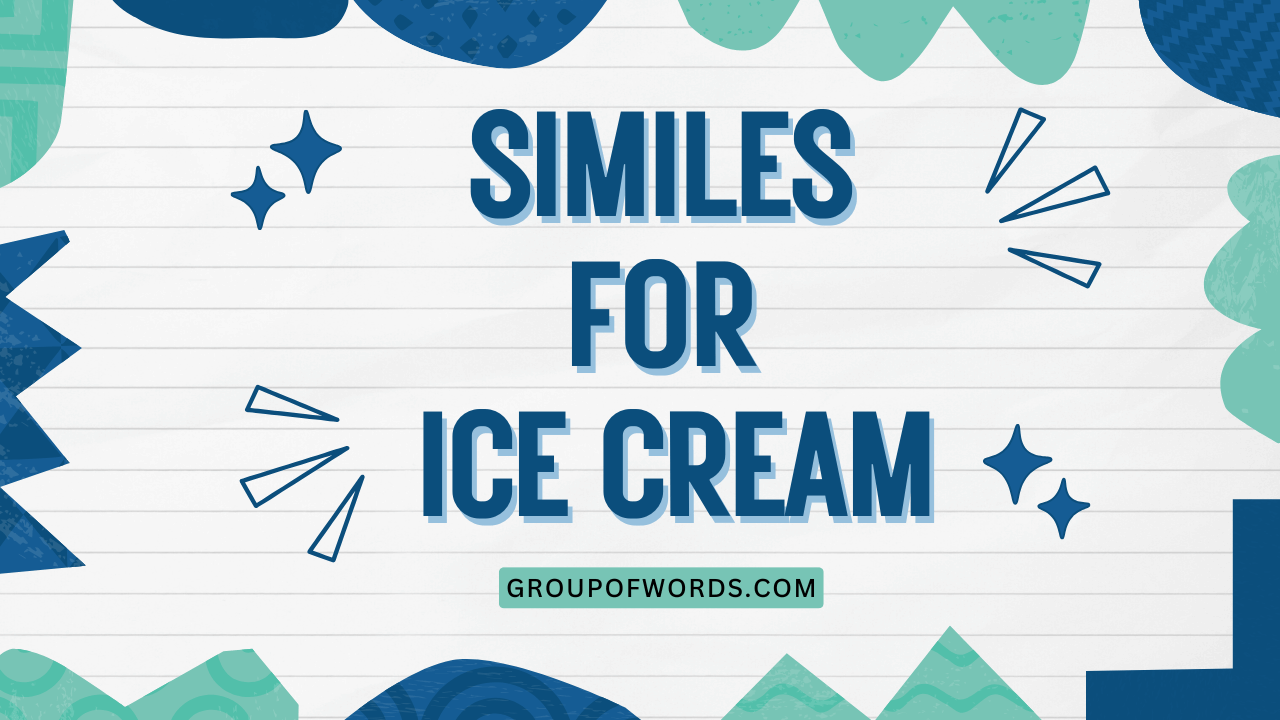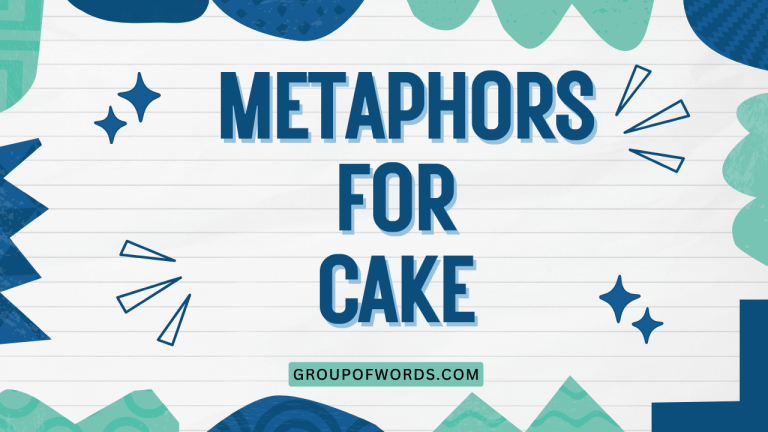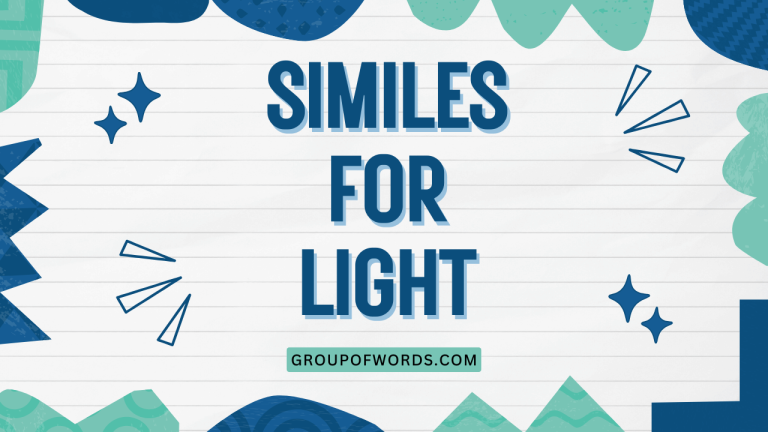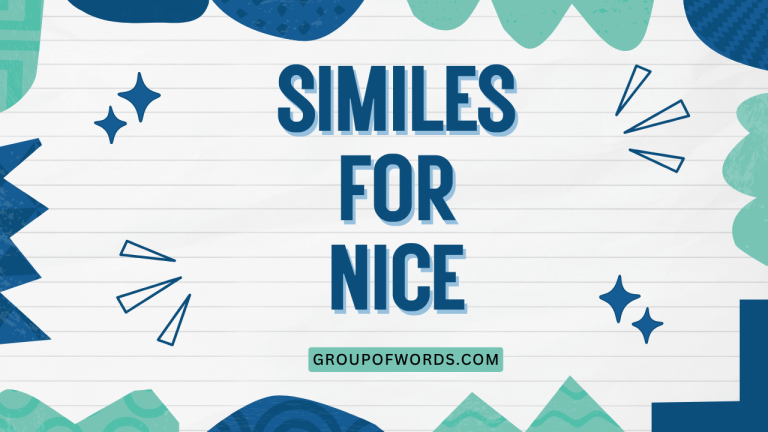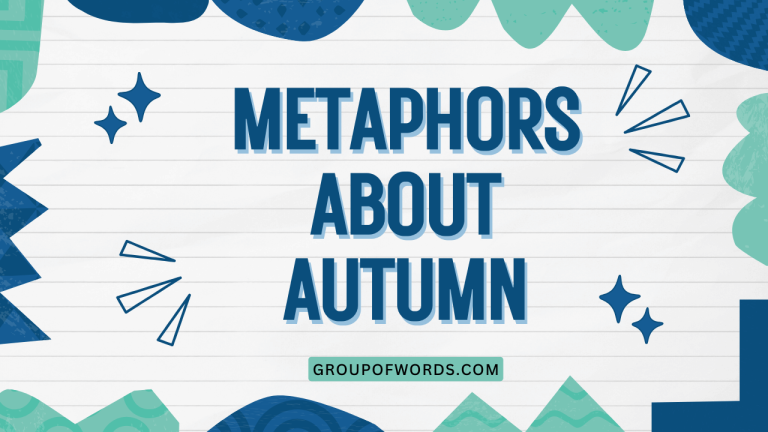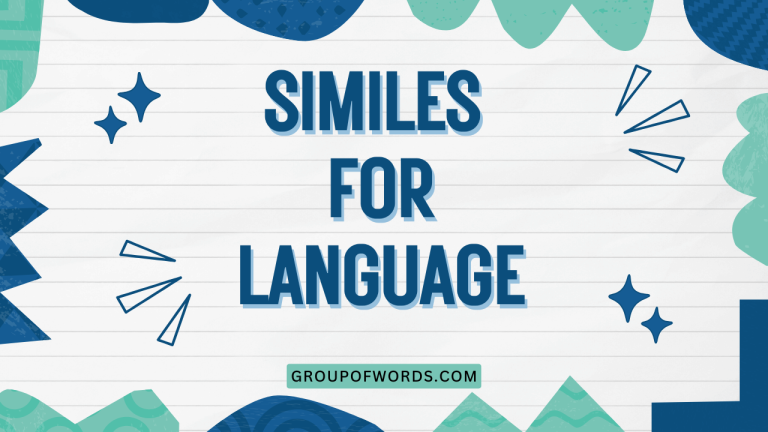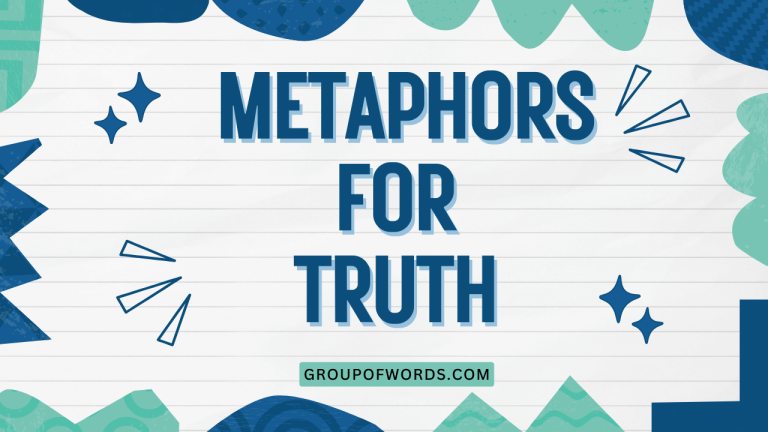Similes for Ice Cream: A Delicious Dive into Figurative Language
Similes are powerful tools in the English language, allowing us to paint vivid pictures and create imaginative comparisons. When it comes to describing something as universally loved as ice cream, similes can take our descriptions from ordinary to extraordinary.
This article explores the art of crafting similes for ice cream, delving into their structure, function, and various creative applications. Whether you’re a student looking to improve your writing skills, a food blogger aiming to tantalize your readers, or simply someone who appreciates the beauty of language, this guide will equip you with the knowledge and inspiration to create delightful similes that capture the essence of ice cream.
Get ready to scoop up some knowledge and explore the sweet world of similes!
This article is designed for students, writers, food enthusiasts, and anyone interested in enhancing their understanding and use of figurative language. By the end of this guide, you’ll be able to confidently create and identify similes for ice cream, enriching your writing and conversations with flavorful descriptions.
Table of Contents
- Introduction
- What is a Simile?
- Structural Breakdown of a Simile
- Types of Similes
- Examples of Similes for Ice Cream
- Usage Rules for Similes
- Common Mistakes with Similes
- Practice Exercises
- Advanced Topics in Similes
- Frequently Asked Questions
- Conclusion
What is a Simile?
A simile is a figure of speech that directly compares two different things, using the words “like” or “as.” Its primary function is to create a vivid and imaginative comparison, helping the reader or listener better understand and visualize the subject. Similes are a fundamental element of figurative language, adding depth, color, and emotional resonance to writing and speech.
Unlike metaphors, which imply that one thing *is* another, similes acknowledge the difference between the two things being compared while highlighting their similarities.
Similes are used in various contexts, from literature and poetry to everyday conversations and advertising. They allow us to express complex ideas in a relatable way, making our communication more engaging and memorable.
By drawing parallels between familiar and unfamiliar concepts, similes enhance understanding and create a more impactful experience for the audience.
Structural Breakdown of a Simile
The structure of a simile is relatively simple, typically consisting of three key components: the subject, the linking word (either “like” or “as”), and the object of comparison. Understanding this structure is crucial for creating effective and meaningful similes.
The subject is the thing being described or compared – in our case, ice cream. The linking word (“like” or “as”) establishes the comparison. The object of comparison is the thing to which the subject is being compared. This object should share a relevant characteristic with the subject to make the simile effective.
For example, in the simile “The ice cream was as cold as ice,” “ice cream” is the subject, “as” is the linking word, and “ice” is the object of comparison. This structure allows for a clear and concise comparison, highlighting the coldness of the ice cream.
Types of Similes
While all similes share the same basic structure, they can be categorized based on the aspect of the subject they emphasize. When describing ice cream, similes can focus on its texture, taste, temperature, appearance, or the overall experience of eating it.
Here are some common types:
Texture-Based Similes
These similes compare the texture of ice cream to other objects or substances. Examples include “smooth like silk,” “creamy as a cloud,” or “grainy like sand” (for less desirable textures).
Taste-Based Similes
These similes focus on the flavor of the ice cream. Examples include “sweet like honey,” “tart as a lemon,” or “rich like chocolate fudge.”
Temperature-Based Similes
These similes highlight the temperature of the ice cream. Examples include “cold as ice,” “freezing like a glacier,” or “chilly as a winter breeze.”
Appearance-Based Similes
These similes describe the visual aspects of the ice cream. Examples include “white as snow,” “colorful like a rainbow,” or “swirled like a galaxy.”
Experience-Based Similes
These similes capture the overall feeling or sensation of eating ice cream. Examples include “refreshing as a cool breeze,” “comforting like a warm hug,” or “uplifting like a sunny day.”
Examples of Similes for Ice Cream
Here are some examples of similes for ice cream, categorized by the aspect they emphasize. Each category provides a variety of options to inspire your own creative writing.
Similes Describing Texture
The texture of ice cream is a crucial part of its appeal. These similes capture the various textures that ice cream can possess, from smooth and creamy to icy and grainy.
The table below presents a variety of similes focused on describing the texture of ice cream, offering different ways to express its mouthfeel.
| Simile | Explanation |
|---|---|
| Smooth like silk | Describes a very smooth and delicate texture. |
| Creamy as a cloud | Implies a light and airy creaminess. |
| Velvety like a rose petal | Suggests a smooth and soft, almost luxurious texture. |
| Grainy like sand | Describes an undesirable, rough texture. |
| Icy like a winter wind | Highlights a cold and slightly crunchy texture. |
| Fluffy like a feather | Indicates a light and airy texture, perhaps referring to whipped ice cream. |
| Thick like pudding | Describes a dense and substantial texture. |
| Light as air | Suggests a very light and delicate texture. |
| Heavy as clay | Implies a dense and rich texture. |
| Runny like water | Describes a melted or poorly made ice cream. |
| As dense as frozen custard | Highlights the richness and thickness of the ice cream. |
| Smooth as a baby’s skin | Emphasizes the delicate and flawless texture. |
| Coarse like gravel | Describes an unpleasantly rough texture. |
| Chewy like taffy | Suggests a texture with some resistance, possibly due to added ingredients. |
| Crystallized like rock candy | Indicates the presence of ice crystals, often undesirable. |
| As airy as meringue | Describes a light and whipped consistency. |
| Firm like fudge | Implies a solid and dense texture. |
| Like biting into a frozen milkshake | Describes the experience of eating a smooth but solid ice cream. |
| As gritty as unsweetened chocolate | Describes a texture that is not smooth, but has small particles. |
| As luscious as melted butter | Highlights the rich and smooth texture. |
| Like the texture of frozen yogurt | Relates the ice cream’s texture to the familiar texture of frozen yogurt. |
| As yielding as soft serve | Highlights the ease with which the ice cream gives way when eaten. |
| As hard as a brick | Describes an extremely firm, almost unyielding texture. |
| Like spooning through cold mud | Highlights the dense, slightly resistant texture. |
| As fine as powdered sugar | Describes a very smooth and delicate texture. |
Similes Describing Taste
The taste of ice cream is often the most memorable aspect. These similes capture the various flavors that ice cream can offer, from sweet and fruity to rich and decadent.
The table below presents a variety of similes focused on describing the taste of ice cream, offering different ways to express its flavor profile.
| Simile | Explanation |
|---|---|
| Sweet like honey | Describes a pure and natural sweetness. |
| Tart as a lemon | Highlights a sour and tangy flavor. |
| Rich like chocolate fudge | Implies a deep and decadent flavor. |
| Fruity like a summer berry | Describes a fresh and vibrant fruit flavor. |
| Minty like toothpaste | Highlights a refreshing and cool mint flavor. |
| Nutty like roasted almonds | Describes a warm and earthy nut flavor. |
| Spicy like cinnamon | Implies a warm and slightly pungent flavor. |
| Vanilla-y like a classic perfume | Describes a smooth and aromatic vanilla flavor. |
| Chocolaty like dark cocoa | Highlights a deep and intense chocolate flavor. |
| Caramelly like burnt sugar | Describes a sweet and slightly bitter caramel flavor. |
| Like sunshine on your tongue | Describes a bright, cheerful, and sweet flavor. |
| As comforting as grandma’s cookies | Implies a familiar and reassuring flavor. |
| Like a burst of summer in your mouth | Describes a fresh, fruity and vibrant flavor. |
| As decadent as a chocolate truffle | Highlights a rich, luxurious, and indulgent flavor. |
| Like biting into a cloud of sugar | Describes a very sweet and airy flavor. |
| As refreshing as a cool drink on a hot day | Highlights a clean and revitalizing flavor. |
| Like a symphony of flavors | Implies a complex and harmonious blend of tastes. |
| As exotic as a tropical fruit salad | Highlights a unique and flavorful taste experience. |
| Like a nostalgic memory in every bite | Describes a flavor that evokes feelings of nostalgia and fond memories. |
| As bright as a citrus grove | Implies a zesty and vibrant flavor. |
| Like a spoonful of pure joy | Describes the overwhelming happiness that the ice cream brings. |
| As intense as espresso | Highlights a strong and bold flavor. |
| Like a secret garden of flavors | Describes a hidden and delightful blend of tastes. |
| As bold as black licorice | Highlights a strong and distinctive flavor. |
| Like biting into a frozen dream | Describes a surreal and delightful flavor experience. |
Similes Describing Temperature
The temperature of ice cream is essential to its enjoyment. These similes capture the coldness of ice cream, emphasizing its refreshing and cooling qualities.
The table below presents a variety of similes focused on describing the temperature of ice cream, offering different ways to express its coolness.
| Simile | Explanation |
|---|---|
| Cold as ice | A classic and straightforward comparison. |
| Freezing like a glacier | Implies an intense level of coldness. |
| Chilly as a winter breeze | Describes a refreshing and invigorating coldness. |
| Icy like a frozen lake | Highlights the solid and unyielding coldness. |
| As frigid as the Arctic | Implies an extreme and biting coldness. |
| Like a blast of winter in your mouth | Describes the sudden and intense feeling of coldness. |
| As frosty as a winter morning | Highlights the crisp and refreshing coldness. |
| Like a polar bear’s hug | Describes an intense and enveloping coldness. |
| As crisp as mountain air | Implies a clean and refreshing coldness. |
| Like a plunge into a cold spring | Describes a sudden and invigorating coldness. |
| As cold as a snowman’s heart | A playful simile emphasizing the intense coldness. |
| Like a shiver down your spine | Describes the sudden sensation of coldness. |
| As chilling as a ghost’s touch | Emphasizes the eerie and intense coldness. |
| Like stepping into an ice cave | Describes the enveloping and intense coldness. |
| As frosty as Jack Frost’s breath | Highlights the crisp and biting coldness. |
| Like a winter storm in your mouth | Describes the intense and overwhelming coldness. |
| As icy as a frozen waterfall | Implies a powerful and unrelenting coldness. |
| Like a deep freeze for your taste buds | Describes the intense and numbing coldness. |
| As refreshing as a snow cone on a hot day | Highlights the revitalizing and cooling effect of the coldness. |
| Like a cold compress for your soul | Describes the soothing and comforting effect of the coldness. |
| As sharp as a snowflake landing on your tongue | Highlights the crisp and delicate sensation of coldness. |
| Like a refreshing dip in an icy pool | Describes the invigorating and revitalizing coldness. |
| As brisk as a winter hike | Implies a coldness that is both invigorating and challenging. |
| Like a breath of fresh winter air | Describes a clean and revitalizing coldness. |
| As cold as a penguin’s feet | A playful simile emphasizing the extreme coldness. |
Similes Describing Appearance
The visual appeal of ice cream can be just as important as its taste and texture. These similes capture the various colors and patterns that ice cream can display, from pure white to vibrant swirls.
The table below presents a variety of similes focused on describing the appearance of ice cream, offering different ways to express its visual appeal.
| Simile | Explanation |
|---|---|
| White as snow | Describes a pure and pristine white color. |
| Colorful like a rainbow | Highlights a vibrant and varied mix of colors. |
| Swirled like a galaxy | Describes a complex and mesmerizing pattern. |
| Golden like the sun | Implies a warm and inviting yellow color. |
| Pink like a flamingo | Describes a bright and cheerful pink color. |
| Brown like rich soil | Highlights a deep and earthy brown color. |
| Green like a summer meadow | Describes a fresh and vibrant green color. |
| Blue like a clear sky | Implies a calming and serene blue color. |
| As vibrant as a bouquet of flowers | Highlights a lively and varied mix of colors. |
| Like a painter’s palette | Describes a colorful and artistic arrangement. |
| As bright as a stained-glass window | A simile to describe the colorful and vibrant appearance. |
| Like a sunset in a bowl | Describes the combination of colors as warm and inviting. |
| As dazzling as a gemstone | Emphasizes the beauty and radiance of the ice cream. |
| Like a work of art | Describes the ice cream’s appearance as meticulously crafted and beautiful. |
| As inviting as a warm hearth | Highlights the comforting and appealing nature. |
| Like a dreamscape of colors | Describes the surreal and enchanting appearance. |
| As picturesque as a postcard | Implies a scene that is perfect and beautiful. |
| Like a kaleidoscope of flavors | Describes the swirling and changing patterns. |
| As enchanting as a fairy garden | Highlights the magical and whimsical appearance. |
| Like a masterpiece of frozen confection | Implies a high level of skill and artistry. |
| As visually pleasing as a perfectly plated dish | Describes the ice cream’s appearance as thoughtfully arranged and attractive. |
| Like a jewel-toned sculpture | Highlights the rich and vibrant colors. |
| As radiant as a summer’s day | Implies a warm and cheerful appearance. |
| Like a burst of confetti | Describes the appearance as festive and celebratory. |
| As stunning as a peacock’s feathers | Highlights the colorful and extravagant appearance. |
Similes Describing the Ice Cream Experience
Eating ice cream is more than just consuming a food; it’s an experience filled with joy, comfort, and nostalgia. These similes capture the overall feeling and sensation of enjoying ice cream.
The table below presents a variety of similes focused on describing the experience of eating ice cream, offering different ways to express the emotions and sensations it evokes.
| Simile | Explanation |
|---|---|
| Refreshing as a cool breeze | Describes the revitalizing and pleasant feeling. |
| Comforting like a warm hug | Implies a sense of security and contentment. |
| Uplifting like a sunny day | Highlights the joyful and cheerful feeling. |
| Satisfying like a perfect ending | Describes the feeling of completeness and contentment. |
| Relaxing like a spa treatment | Implies a sense of calm and tranquility. |
| Exciting like a roller coaster | Highlights the thrilling and enjoyable feeling. |
| Soothing like a lullaby | Describes a gentle and comforting feeling. |
| Rewarding like a gold medal | Implies a sense of accomplishment and satisfaction. |
| Invigorating like a morning run | Describes a revitalizing and energizing feeling. |
| Dreamy like a peaceful sleep | Implies a sense of calm and pleasant escape. |
| Like a vacation for your taste buds | Describes the enjoyable and refreshing experience. |
| As delightful as a child’s laughter | Highlights the pure and innocent joy. |
| Like a sweet escape from reality | Describes the temporary relief and pleasure. |
| As treasured as a childhood memory | Implies a sense of nostalgia and fondness. |
| Like a burst of pure happiness | Describes the overwhelming feeling of joy. |
| As satisfying as reaching a goal | Highlights the sense of accomplishment. |
| Like a warm blanket on a cold night | Describes the feeling of comfort and security. |
| As magical as a starry night | Implies a sense of wonder and enchantment. |
| Like a ray of sunshine on a cloudy day | Describes the feeling of hope and happiness. |
| As comforting as a mother’s embrace | Highlights the sense of security and love. |
| Like a nostalgic trip down memory lane | Describes the feeling of reminiscing about the past. |
| As pleasurable as a perfect melody | Implies a sense of harmony and satisfaction. |
| Like a soothing balm for the soul | Describes the feeling of comfort and healing. |
| As revitalizing as a spa day | Highlights the feeling of refreshment and renewal. |
| Like a sweet reward after a long day | Describes the feeling of well-deserved pleasure. |
Usage Rules for Similes
While similes are relatively simple to create, there are some usage rules to keep in mind to ensure clarity and effectiveness. Here are some key guidelines:
- Ensure a Clear Connection: The object of comparison should have a clear and relevant connection to the subject. The comparison should be easily understood by the audience.
- Avoid Clichés: Overused similes, such as “as cold as ice,” can lose their impact. Strive for originality and creativity in your comparisons.
- Maintain Consistency: The tone and style of the simile should be consistent with the overall tone and style of your writing.
- Consider the Audience: Choose comparisons that are appropriate for your target audience. What might be effective for children may not be effective for adults.
- Use Sparingly: While similes can enhance your writing, overuse can make it seem forced or unnatural. Use them judiciously to create the greatest impact.
Common Mistakes with Similes
Even experienced writers can make mistakes with similes. Here are some common errors to avoid:
Using Metaphors Instead of Similes: Confusing similes with metaphors is a common mistake. Remember that similes use “like” or “as” to make a direct comparison, while metaphors imply that one thing *is* another.
Incorrect: The ice cream was a cold glacier. (Metaphor)
Correct: The ice cream was as cold as a glacier. (Simile)
Creating Unclear Comparisons: The object of comparison should be easily understood and share a relevant characteristic with the subject.
Incorrect: The ice cream was like a Tuesday. (Unclear comparison)
Correct: The ice cream was as refreshing as a summer breeze. (Clear comparison)
Using Clichéd Similes: Overused similes can lose their impact and make your writing seem unoriginal.
Incorrect: The ice cream was as sweet as sugar. (Cliché)
Correct: The ice cream was as sweet as wildflower honey. (More original)
Inconsistent Tone: The tone of the simile should match the overall tone of your writing.
Incorrect: The ice cream was as delicious as a gourmet meal, like eating dirt. (Inconsistent tone)
Correct: The ice cream was as delicious as a gourmet meal, a true culinary delight. (Consistent tone)
Practice Exercises
Test your understanding of similes with these practice exercises. For each sentence, create a simile using “like” or “as” to describe the ice cream.
Exercise 1: Identifying Similes
Read each sentence and identify if it contains a simile. If it does, write the simile.
If not, write “No simile.”
| Question | Answer |
|---|---|
| 1. The ice cream was cold. | No simile |
| 2. The ice cream was as smooth as silk. | As smooth as silk |
| 3. This ice cream is a dream. | No simile |
| 4. The flavor was like sunshine on a summer day. | Like sunshine on a summer day |
| 5. The texture of the ice cream was velvety. | No simile |
| 6. It was as refreshing as a cool breeze. | As refreshing as a cool breeze |
| 7. This ice cream is pure heaven. | No simile |
| 8. The ice cream was swirled like a galaxy. | Swirled like a galaxy |
| 9. Enjoying ice cream is the best thing ever. | No simile |
| 10. It tasted as rich as chocolate fudge. | As rich as chocolate fudge |
Exercise 2: Completing Similes
Complete each simile with an appropriate comparison.
| Question | Answer |
|---|---|
| 1. The ice cream was as cold as __________. | 1. The ice cream was as cold as ice. |
| 2. The taste was like __________. | 2. The taste was like honey. |
| 3. It was as smooth as __________. | 3. It was as smooth as velvet. |
| 4. The color was like __________. | 4. The color was like gold. |
| 5. Eating it was like __________. | 5. Eating it was like a dream. |
| 6. The texture was as airy as __________. | 6. The texture was as airy as a cloud. |
| 7. It was as refreshing as __________. | 7. It was as refreshing as a mountain spring. |
| 8. The flavor was like __________. | 8. The flavor was like a summer berry. |
| 9. The experience was like __________. | 9. The experience was like a warm hug. |
| 10. It looked as vibrant as __________. | 10. It looked as vibrant as a rainbow. |
Exercise 3: Creating Similes
Create your own similes to describe the following aspects of ice cream:
| Aspect | Your Simile |
|---|---|
| 1. The flavor of strawberry ice cream | 1. The flavor of strawberry ice cream was like biting into a fresh, ripe strawberry. |
| 2. The texture of chocolate ice cream | 2. The texture of chocolate ice cream was as smooth as melted chocolate. |
| 3. The coldness of mint ice cream | 3. The coldness of mint ice cream was like a winter breeze on a hot day. |
| 4. The appearance of Neapolitan ice cream | 4. The appearance of Neapolitan ice cream was as colorful as a box of crayons. |
| 5. The experience of eating ice cream on a hot day | 5. The experience of eating ice cream on a hot day was as refreshing as diving into a cool pool. |
| 6. The taste of vanilla ice cream | 6. The taste of vanilla ice cream was as comforting as a familiar song. |
| 7. The texture of rocky road ice cream | 7. The texture of rocky road ice cream was like a treasure hunt of chewy marshmallows and crunchy nuts. |
| 8. The coldness of sherbet | 8. The coldness of sherbet was as sharp as a burst of citrus. |
| 9. The appearance of cookies and cream ice cream | 9. The appearance of cookies and cream ice cream was like a starry night sky with cookie pieces as the stars. |
| 10. The experience of sharing ice cream with friends | 10. The experience of sharing ice cream with friends was as sweet as the ice cream itself. |
Advanced Topics in Similes
For advanced learners, exploring more complex aspects of similes can further enhance your writing skills. This includes understanding the use of extended similes, mixed metaphors (which should generally be avoided, but understanding them is useful), and the creation of original and unexpected comparisons.
Extended Similes: An extended simile develops a comparison over several lines or paragraphs, providing a more detailed and nuanced description. This technique can create a more vivid and memorable image in the reader’s mind.
Original Comparisons: The most effective similes are often those that are original and unexpected. Strive to find unique and imaginative ways to compare ice cream to other things, avoiding clichés and common comparisons.
Frequently Asked Questions
Here are some frequently asked questions about similes:
Q1: What is the difference between a simile and a metaphor?
A1: A simile is a direct comparison using “like” or “as,” while a metaphor implies that one thing *is* another. Similes acknowledge the difference between the two things being compared, while metaphors create a stronger, more symbolic connection.
Q2: Can a simile be too long?
A2: Yes, a simile can be too long if it becomes convoluted or detracts from the main point. An extended simile can be effective if used skillfully, but it should still be concise and relevant.
Q3: How can I create more original similes?
A3: To create more original similes, think outside the box and look for unexpected connections between the subject and object of comparison. Consider using sensory details and personal experiences to make your similes more unique and memorable.
Q4: Is it okay to use similes in formal writing?
A4: Yes, similes can be used in formal writing, but they should be used judiciously and with careful consideration of the audience and context. Avoid overly casual or informal comparisons.
Q5: What is the purpose of using similes in writing?
A5: The purpose of using similes is to create vivid and imaginative comparisons, enhance understanding, add depth and color to writing, and make communication more engaging and memorable.
Q6: How do I avoid using clichéd similes?
A6: To avoid using clichéd similes, brainstorm alternative comparisons and focus on unique and unexpected connections. Use a thesaurus to find synonyms for common comparison words and phrases.
Q7: Can I use similes in all types of writing?
A7: Yes, similes can be used in various types of writing, including creative writing, descriptive writing, persuasive writing, and even technical writing, as long as they enhance clarity and understanding.
Q8: What makes a simile effective?
A8: An effective simile is clear, relevant, original, and consistent with the tone and style of the writing. It should create a vivid and memorable image in the reader’s mind and enhance understanding of the subject.
Conclusion
Similes are a valuable tool for enhancing your writing and communication skills. By understanding their structure, function, and
creative applications, you can craft vivid and memorable descriptions that captivate your audience.
Whether you’re describing the texture, taste, temperature, appearance, or overall experience of ice cream, similes can elevate your writing and make it more engaging. So go ahead, experiment with different comparisons, and let your imagination run wild.
With practice and creativity, you can master the art of crafting similes and bring your writing to life.
